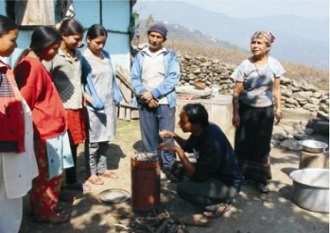The scourge of so-called “flying toilets” – where human waste is put into a plastic bag and tossed into the air, landing on roads or in gutters – has plagued the slums of Kenya’s capital Nairobi for decades. But an innovative project in the slum of Kibera has dramatically cut down on the problem by converting human waste into gas that can be used to fuel cookers and other devices.
 |
| Roseline Amondi cooks githeri at the community kitchen powered by gas from the community toilet in Kibera, Kenya |
Roseline Amondi is cooking up a storm. Today’s menu for the tiny restaurant she runs is githeri, a traditional dish consisting of beans and maize.
Amondi cooks every day in this community kitchen. She will then take the food back to her kiosk to sell to her customers. She says the community stove saves her a lot of money that she would otherwise spend on charcoal or wood.
“Before the gas started working, I was using almost 100 or 200 [shillings] per day for cooking any meal in the house, but right now, it is only 10 bob [shillings] per meal,” she said. “It is very cheap. If I cook two different types of food, I may use only 30 shillings for the whole day. That is wonderful.”
The gas that Amondi uses comes from an unlikely source, the community toilet. This is a rare sight in Kibera, where up to 200 people can share a single latrine in neighborhoods that have no electricity or running water.
 |
| The TOSHA community toilets in Kibera slum |
The toilet and kitchen are run by a coalition of five community groups calling themselves TOSHA (Total Sanitation and Hygiene Access). “Tosha” also means “enough” in the national language Ki’Swahili.
Some 600 people a day use the toilets for a small fee.
The human waste is transported via pipes into an underground tank, where it is converted into bio-gas.
The gas is then piped up to the community kitchen, where members can use the stove for pennies per pot.
Groups often rent out the facility’s top floor for meetings and functions. TOSHA earns some $400 each month renting out the facility, the community kitchen and use of the toilets.
Aidah Binale is a coordinator with Umande Trust, a development group that partnered with TOSHA to formulate the project.
She says it was difficult at first for community members to accept the gas.
“People will have the idea of, ‘Ah, no, I can’t cook from there, it is from [human] waste.’ Right now we are still trying to capacity build, we are trying to tell them [there is] nothing wrong,” she explained. “We get to have more visitors from different countries coming to visit us. We make sure that when they come to the office, we tell them, ‘Let’s go down there and have tea.’ So when the community comes and sees us drinking tea, they are thinking, ‘Ah, this is a foreigner taking tea. These people are taking tea, we can also cook.'”
Running water and sanitation facilities are virtually non-existent in slums like Kibera, where most people earn less than $1 a day. Human waste in plastic bags is often dumped on roads, alleys and gutters.
But locals say there has been a dramatic reduction in these so-called “flying toilets” since the bio-gas center was constructed two years ago.
Roseline Amondi is also secretary of TOSHA.
“At the time we were using flying toilets, there were so many diseases around us like cholera,” she noted. “Once an outbreak of cholera occurs, we are the sufferer. Many of us died, some got into the hospitals. But right now, for the last three months, there was an outbreak [of cholera] within Nairobi, but we were safe because of the bio-center.”
Project supporters say the TOSHA Bio-Gas Centre is a model for communities everywhere, especially those dealing with power shortages.
Paul Muchire, communication manager with Umande Trust.
“We have the problem of [supplying enough] energy. Poverty levels are going up. Sanitation is a problem in the developing world. We have the issue of pollution from the oil and diesel. There is need to go into other sources of energy, adapt other sources of energy that would be environmentally friendly,” he said.
Muchire says there are about 10 bio-gas centers in Kibera under construction and that an engineer is looking at how the gas can be piped into peoples’ homes.
Source – http://www.voanews.com/english/2009-11-07-voa17.cfm



